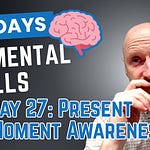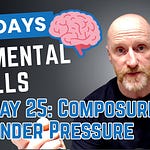The paper "Mental Imagery and Its Potential for Physical Therapy" by Warner and McNeill (1988)1 reviewed the existing literature on mental imagery (MI) and mental practice (MP) and their effects on physical skills. The authors aimed to explore the feasibility of these techniques as a supplement to physical therapy. The core premise is that mental processes, particularly imagery, have a tangible influence on physical functions, reflecting a strong mind-body relationship.
In 1954, Roger Bannister became the first person to run one mile under four minutes, after which 52 others followed suit the same year. According to pentathlete Marilyn King in a 1985 interview2, Bannister had a mental image of being able to surpass the then-existing record, despite "irrefutable" evidence that it was impossible. Olympic champion King trained athletes to utilise Mental Imagery and advocates for a shift in attitude that creates possibilities beyond what individuals think they are capable of. In other words, it is unlikely that one's body will do more than one's mind believes is possible.
Mental Imagery can be defined as "cognitively reproducing or visualising an object, scene, or sensation as though it were occurring in overt, physical reality". Mental practice is defined as the "symbolic rehearsal of a physical activity in the absence of any gross muscular movements," achieved through the repetitive use of MI to reach a desired outcome. The paper presents compelling evidence for this mind-body connection as follows;
Perception and Visualisation Similarities: Research by Finke found that mental images exhibit visual properties much like the perception of actual objects, supporting the use of MI for practical purposes like athletic training, which I discussed on Day 17 and Day 18.
Brain Activity Beyond Visual Cortex: Studies using brain electrical activity mapping and positron emission tomography have revealed that mental imaging activates brain areas involved in movement execution (e.g., parietal cortex) in addition to regions involved in visual processing. This suggests MI "mimics actual performance to a greater degree than had been thought previously".
Measurable Muscle Activation: Early electromyography (EMG) studies by Jacobson (1932)3 demonstrated slight, transitory muscle contractions during MI. While some initial reviews suggested general body activation rather than mirroring specific movement patterns, later research by Harris and Robinson (1986)4 provided evidence for site-specific muscular activity.
Crucially, kinaesthetic imagery, or "visuomotor behavioural rehearsal (VMBR)," which involves mentally recreating the total "feel" of an activity, has been shown to generate EMG activity that matches actual physical performance—we’ve mentioned this before. This muscle activation, in conjunction with Motor Imagery, underscores the direct link.
The effectiveness of MI and MP has been extensively studied, particularly in sports and motor learning:
Skill Enhancement: Numerous studies demonstrate that MP can enhance skillfulness. Classic research showed that groups mentally practising basketball free throws or dart throwing improved similarly to those physically practising. More recent studies have replicated these findings.
Cognitive vs. Motor Tasks: Mental practice showed the most pronounced effects and quickest improvement for cognitively oriented tasks (e.g., maze learning, card sorting), while motor skills required more trials and longer sessions for less dramatic improvement.
Key variables influencing the successful outcome of MI and MP include:
Vividness and Clarity: Superior results are associated with strong, clear images, which tend to improve with experience and by keeping images simple.
Kinesthetic Imagery: Focusing on the internal "feeling" of the movement, as in VMBR, is critical.
Practice Over Time: Achieving significant results depends on consistently conducting Mental Imagery sessions over time, rather than sporadically or in single instances. A minimum of five sessions, held on separate days, is recommended.
Nondirected Instructions: Allowing subjects to create their own personalised, active mental images is generally more effective than using audiotaped or directed instructions.
Combining Practice Methods: Integrating physical practice (PP) with Mental Practice often leads to the most significant gains in performance.
Positive Outcomes: Visualising successful outcomes and perfect movements also contributes to effectiveness.
The paper extends the discussion to health care services, citing evidence for MI's physiological impact:
Cancer Therapy and Psychoneuroimmunology: Mental Imagery has been used to influence immune responses, with patients visualising symbolic ways to fight cancer cells, correlating with increased survival rates and enhanced white blood cell counts.
Biofeedback: Individuals can mentally influence autonomic functions, such as heart rate, muscle tension, and skin temperature, using Mental Imagery techniques, often in conjunction with biofeedback technology.
Physical Therapy Potential: Due to physical limitations and safety concerns, particularly among the elderly, Mental Practice is highly applicable in physical therapy. A study on balance in elderly women showed that mental practice incorporating relaxation and kinaesthetic imagery significantly improved balance.
The advantages of MI/MP in physical therapy are numerous:
Immediate Implementation: It requires no special equipment, is easily taught, and can be used when physical practice is impractical due to immobilisation, pain, or fatigue.
Neuroanatomical Circuit Maintenance: It can help keep neural pathways functional when a body part is immobilised.
Accelerated Recovery: Patients can begin mental practice during recovery, potentially reducing healing time and allowing for home practice without specialised equipment.
Psychological Benefits: It aids in stress reduction, enhances concentration and confidence, and facilitates more relaxed performances.
However, the paper acknowledges disadvantages: patients may perceive it as too simple, be sceptical of its effects, feel progress is too slow, or therapists may find it challenging to correct covert mental activities.
In conclusion, the paper asserts that MI has a significant impact on physiological functions and consistently yields physical results in sports and healthcare. It emphasises that mental practice is not merely "thinking about" an action but actively engaging the brain's motor system in a way that closely mimics actual performance, thereby enabling enhanced physical recovery, performance, mental clarity, and stress reduction. The authors highlight the potential of MI to expand perceptions of human capabilities and serve as a "more inclusive treatment program".
Mental Skills Basics Course
Suffering stress and anxiety is not a prerequisite for success in self-employment–there's a better way. Mental skills provide you with the means of coping effectively with difficulty and achieving your goals. I created the Mental Skills Basics Course to introduce business leaders, self-employed individuals, freelancers, consultants, and small business owners to the psychological and emotional skills associated with success.
References
Warner, L., & McNeill, M. E. (1988). Mental Imagery and Its Potential in Physical Therapy. Physical therapy, 68(4), 516-521.
McNeill B (1985) Beyond sports: Imaging in daily life-an interview with Marilyn King. Institute of Noetic Sciences Newsletter 13(2):14-16
Jacobson E: (1932) Electrophysiology of mental activities. American Journal of Psychology 44:677- 694
Harris DV, Robinson WJ (1986) The effects of skill level on EMG activity during internal and external imagery. Journal of Sport Psychology 8:105-111










